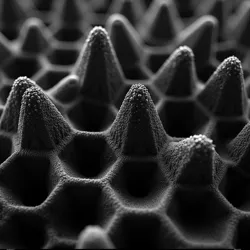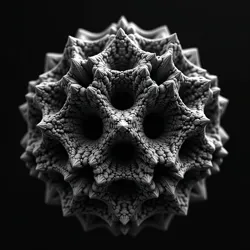Umbral Carbon
 Electron microscope image showing the unique crystalline lattice of Umbral Carbon with its characteristic void pockets
Electron microscope image showing the unique crystalline lattice of Umbral Carbon with its characteristic void pocketsUmbral Carbon represents one of the most significant advances in ultra-black material science, developed through the collaboration between the Meridian Institute of Chromatic Sciences and the Guild of Systematic Thaumaturgy during the late Age of Innovation. This engineered substance achieves a remarkable 99.99% light absorption rate across the visible spectrum through a unique combination of material properties and subtle thaumaturgical enhancement.
Composition and Structure
At its core, Umbral Carbon consists of a specially modified carbon allotrope featuring a complex crystalline structure interwoven with microscopic pockets of stabilized void essence. These void pockets, measuring only nanometers across, create what researchers term "light traps" - regions where photons enter but cannot escape. The carbon framework itself is grown through a process of arcane crystallization under carefully controlled conditions, resulting in a forest-like arrangement of carbon nanotubes aligned perpendicular to the substrate surface.
The material's exceptional absorption properties stem from its unique multi-layered structure. The outermost layer consists of precisely arranged carbon pyramids that direct incoming light into deeper layers of the material. As light penetrates further, it encounters increasingly dense networks of carbon nanotubes infused with trace amounts of shadowmatter, effectively eliminating any possibility of reflection or scattering.
Development History
The development of Umbral Carbon began as an attempt to create a more stable and controllable alternative to Voidure Black. Led by Dr. Mariana Shadowweaver, the research team sought to combine conventional material science with controlled applications of shadow magic to achieve unprecedented levels of light absorption without the dangerous matter-consuming properties of its predecessor.
The breakthrough came when researchers discovered that exposing carbon structures to controlled bursts of thaumic flux during the growth process created stable microscopic void pockets within the material. This discovery built upon earlier work documented in the Treatise on Shadow Integration, though applied in a novel materials science context.
Manufacturing Process
 Interior view of a certified Umbral Carbon manufacturing facility showing the specialized growth chambers
Interior view of a certified Umbral Carbon manufacturing facility showing the specialized growth chambersThe production of Umbral Carbon requires highly specialized facilities equipped with both advanced materials processing technology and carefully calibrated thaumic field generators. The base carbon substrate must be grown in chambers maintained at precisely -273.16°C, a temperature known as the Shadow Point where certain magical effects become more pronounced in physical matter.
The manufacturing process involves several distinct phases, each carefully monitored by both scientific instruments and trained thaumic sensors. During the initial growth phase, carbon vapor is deposited onto specialized substrates while being subjected to carefully modulated fields of shadow energy. The resulting structures are then treated with a series of stabilizing enchantments to prevent degradation and ensure consistent performance.
Applications
Umbral Carbon has found widespread application in various scientific and industrial contexts, particularly in optical instruments and energy collection systems. The material's exceptional absorption properties make it invaluable for high-precision optical measurements and in the construction of advanced void chambers, though its applications remain limited compared to conventional materials due to its complex and expensive production process.
In astronomical research, Umbral Carbon coatings have revolutionized telescope design by virtually eliminating internal reflections and stray light. The Celestial Observatory of Shadowhaven employs Umbral Carbon in its primary imaging arrays, achieving unprecedented sensitivity in observing distant celestial phenomena.
The material has also found important applications in energy management systems, where its ability to absorb and safely dissipate various forms of radiation has proved invaluable. Several leading thaumaturgical reactors use Umbral Carbon components in their cooling systems, taking advantage of its unique properties to manage excess energy without risk of dangerous feedback loops.
Safety and Handling
Unlike Voidure Black, Umbral Carbon maintains stable absorption properties without the risk of uncontrolled matter consumption. However, the material still requires careful handling and specific safety protocols. Extended direct contact with Umbral Carbon surfaces can cause temporary sensory disorientation due to the complete absence of reflected light, a phenomenon known as "shadow blindness."
The International Council of Chromatic Control classifies Umbral Carbon as a Class-γ controlled substance, requiring certification for its production and use but allowing for broader commercial applications than more dangerous ultra-black materials. All manufacturing facilities must maintain strict environmental controls and regular safety inspections to prevent any degradation of the material's stable properties.
Theoretical Significance
The successful development of Umbral Carbon has provided valuable insights into the relationship between physical matter and shadow energy. The material's properties have helped validate several key principles of the Theory of Chromatic Interconnection, particularly regarding the stability threshold of void-matter interfaces.
Research continues into the fundamental mechanisms behind Umbral Carbon's absorption properties, with some theorists suggesting connections to principles first proposed in the Codex of Forbidden Exchanges. The material's ability to maintain stable void pockets without degradation has sparked new areas of investigation in both materials science and thaumaturgical research.
See Also
- Shadow Integration Theory
- Void-Matter Interface Studies
- Standard Spectrum of Arcane Colorology
References
- "Advanced Applications of Umbral Carbon in Modern Thaumaturgy" - Journal of Applied Shadow Sciences
- "The Development and Stabilization of Ultra-Black Materials" - Meridian Institute Technical Review
- "Shadow Matter Integration in Modern Materials" - Proceedings of the Guild of Systematic Thaumaturgy